Managing Change at Woolworths: ADKAR Model and Implementation
VerifiedAdded on 2023/04/23
|18
|4141
|460
Report
AI Summary
This report provides a comprehensive analysis of change management within Woolworths, focusing on the implementation of the ADKAR model. The report begins with an executive summary outlining the objectives and structure, followed by a detailed breakdown of Task 1. This task involves developing corrective actions using the ADKAR model, guiding the change management process, and measuring its progress. The report addresses issues related to human resource management and strategic management, proposing interventions to improve employee retention, communication, organizational culture, and motivation. The transition stage of the ADKAR model is discussed, outlining strategies to implement change, including the use of Lean Approach and Customer Relationship Management (CRM). The report also applies Oakland's figure eight framework to guide the change management process, providing a structured approach to achieving the desired outcomes. The report emphasizes the importance of training, incentives, and work-life balance to facilitate a successful change implementation within Woolworths, and also includes a brief reflection on the change management experience.
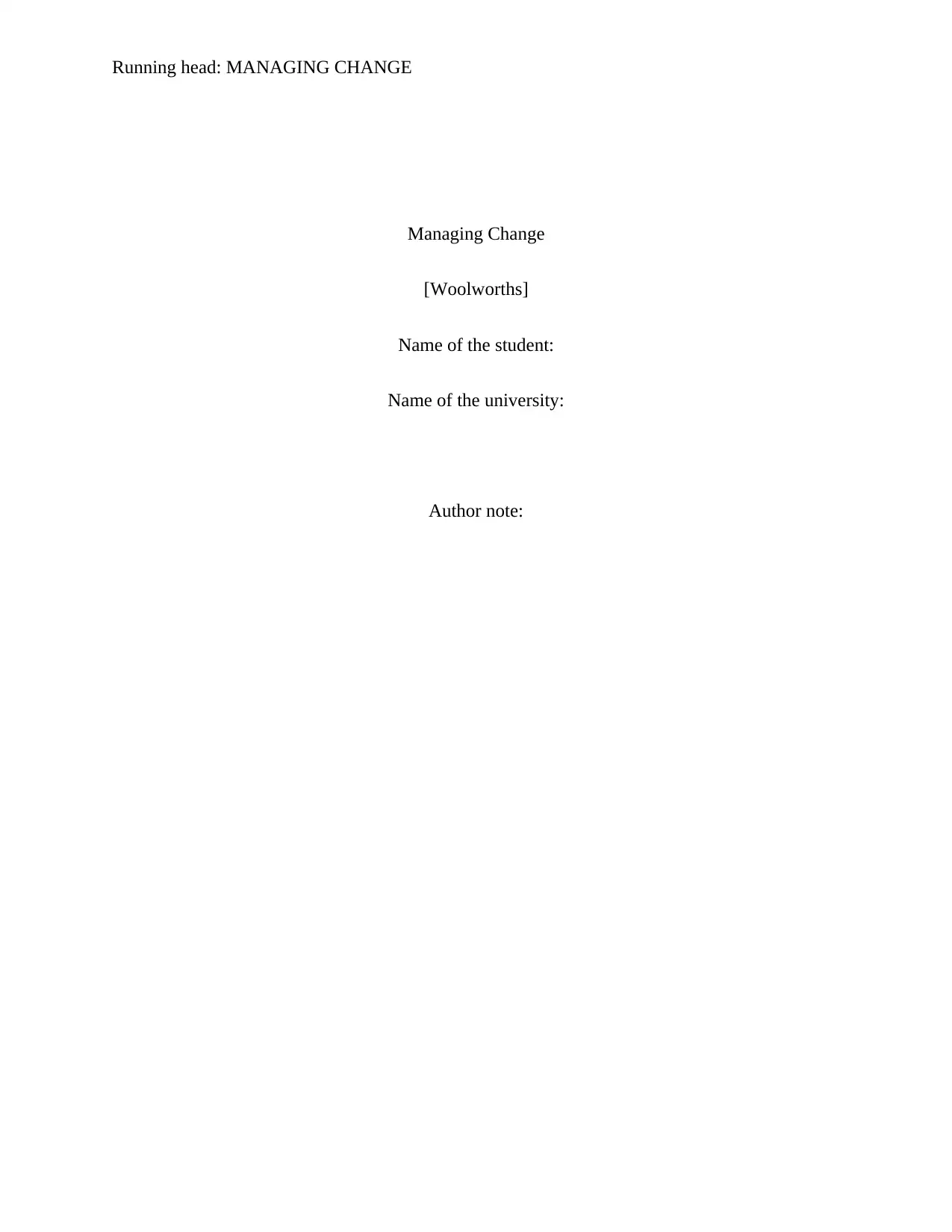
Running head: MANAGING CHANGE
Managing Change
[Woolworths]
Name of the student:
Name of the university:
Author note:
Managing Change
[Woolworths]
Name of the student:
Name of the university:
Author note:
Paraphrase This Document
Need a fresh take? Get an instant paraphrase of this document with our AI Paraphraser
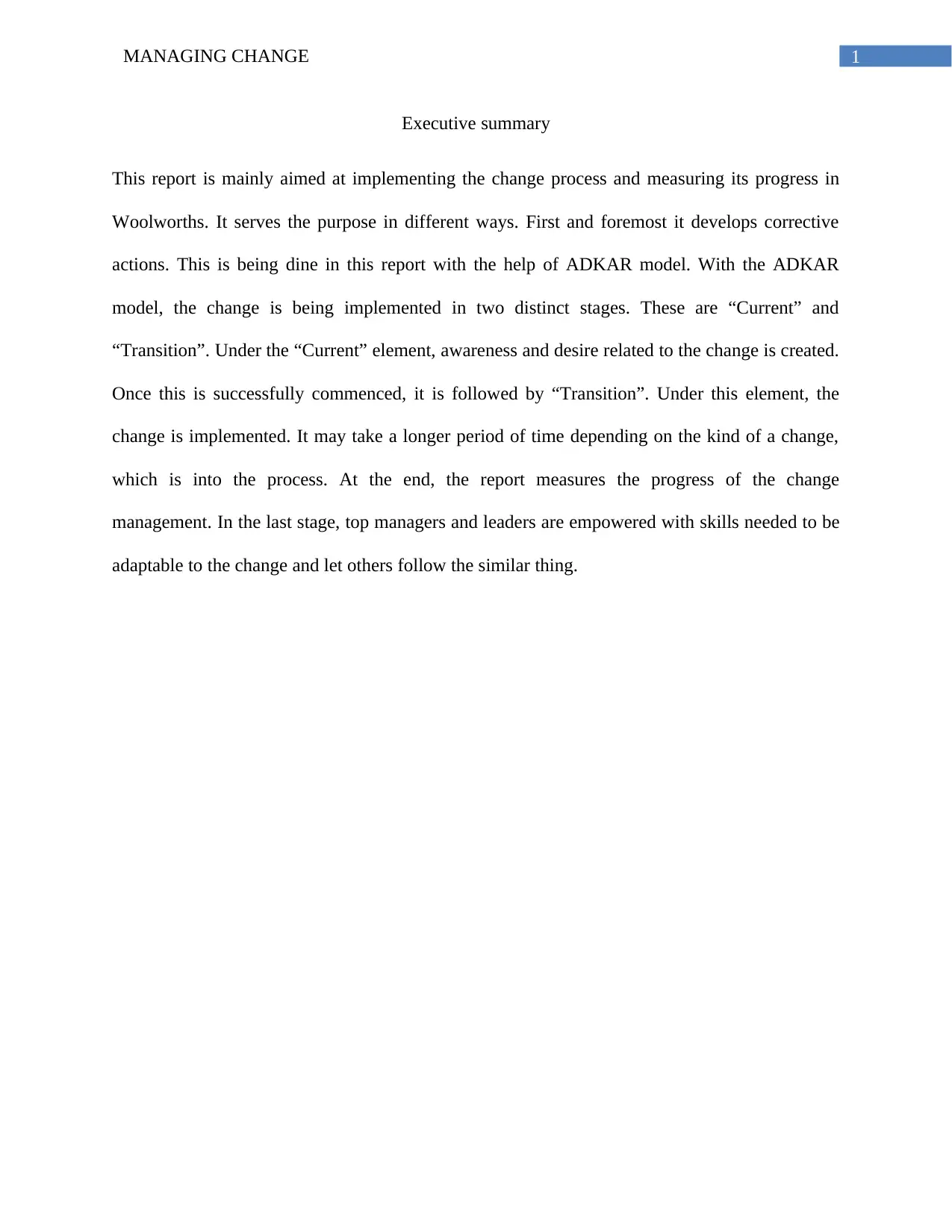
1MANAGING CHANGE
Executive summary
This report is mainly aimed at implementing the change process and measuring its progress in
Woolworths. It serves the purpose in different ways. First and foremost it develops corrective
actions. This is being dine in this report with the help of ADKAR model. With the ADKAR
model, the change is being implemented in two distinct stages. These are “Current” and
“Transition”. Under the “Current” element, awareness and desire related to the change is created.
Once this is successfully commenced, it is followed by “Transition”. Under this element, the
change is implemented. It may take a longer period of time depending on the kind of a change,
which is into the process. At the end, the report measures the progress of the change
management. In the last stage, top managers and leaders are empowered with skills needed to be
adaptable to the change and let others follow the similar thing.
Executive summary
This report is mainly aimed at implementing the change process and measuring its progress in
Woolworths. It serves the purpose in different ways. First and foremost it develops corrective
actions. This is being dine in this report with the help of ADKAR model. With the ADKAR
model, the change is being implemented in two distinct stages. These are “Current” and
“Transition”. Under the “Current” element, awareness and desire related to the change is created.
Once this is successfully commenced, it is followed by “Transition”. Under this element, the
change is implemented. It may take a longer period of time depending on the kind of a change,
which is into the process. At the end, the report measures the progress of the change
management. In the last stage, top managers and leaders are empowered with skills needed to be
adaptable to the change and let others follow the similar thing.
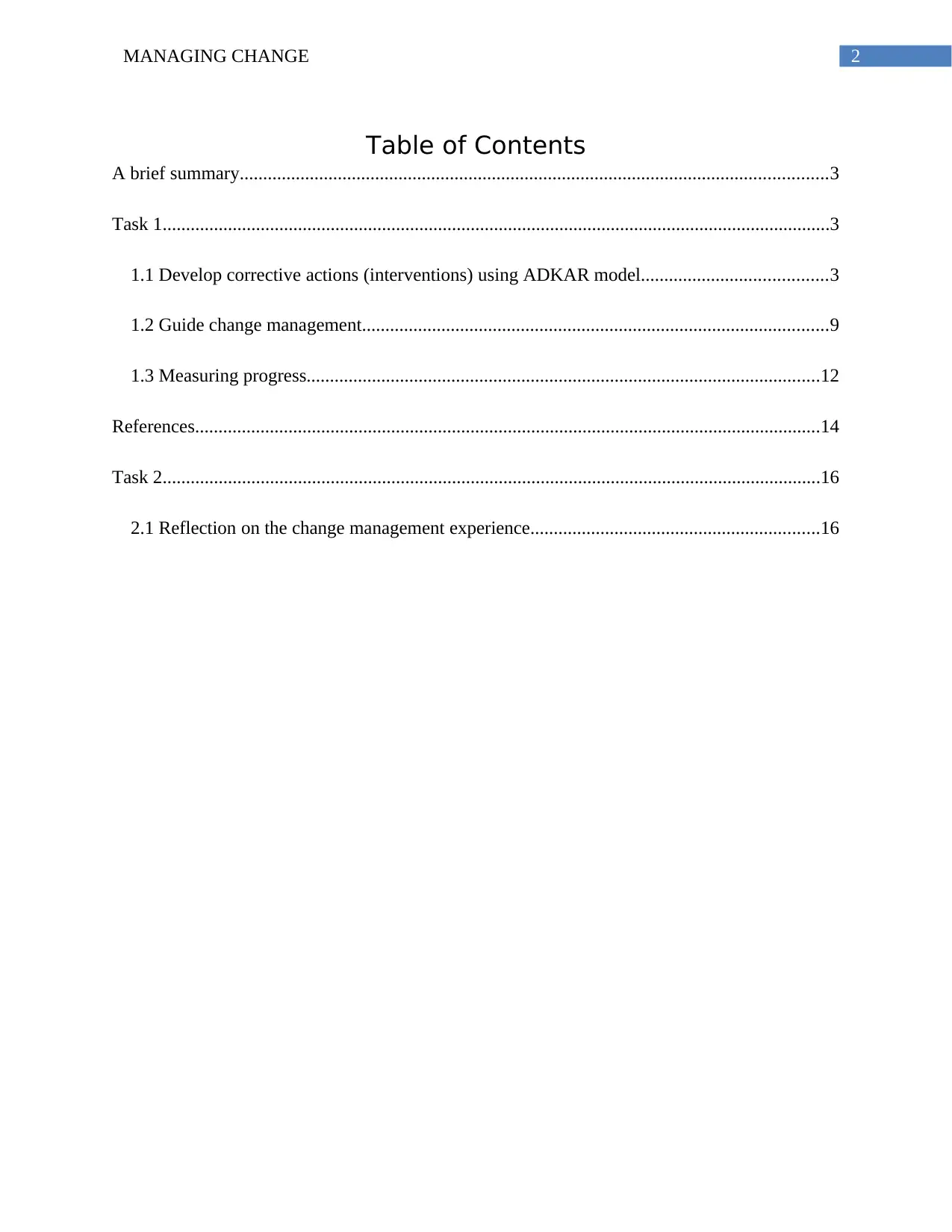
2MANAGING CHANGE
Table of Contents
A brief summary..............................................................................................................................3
Task 1...............................................................................................................................................3
1.1 Develop corrective actions (interventions) using ADKAR model........................................3
1.2 Guide change management....................................................................................................9
1.3 Measuring progress..............................................................................................................12
References......................................................................................................................................14
Task 2.............................................................................................................................................16
2.1 Reflection on the change management experience..............................................................16
Table of Contents
A brief summary..............................................................................................................................3
Task 1...............................................................................................................................................3
1.1 Develop corrective actions (interventions) using ADKAR model........................................3
1.2 Guide change management....................................................................................................9
1.3 Measuring progress..............................................................................................................12
References......................................................................................................................................14
Task 2.............................................................................................................................................16
2.1 Reflection on the change management experience..............................................................16
⊘ This is a preview!⊘
Do you want full access?
Subscribe today to unlock all pages.

Trusted by 1+ million students worldwide
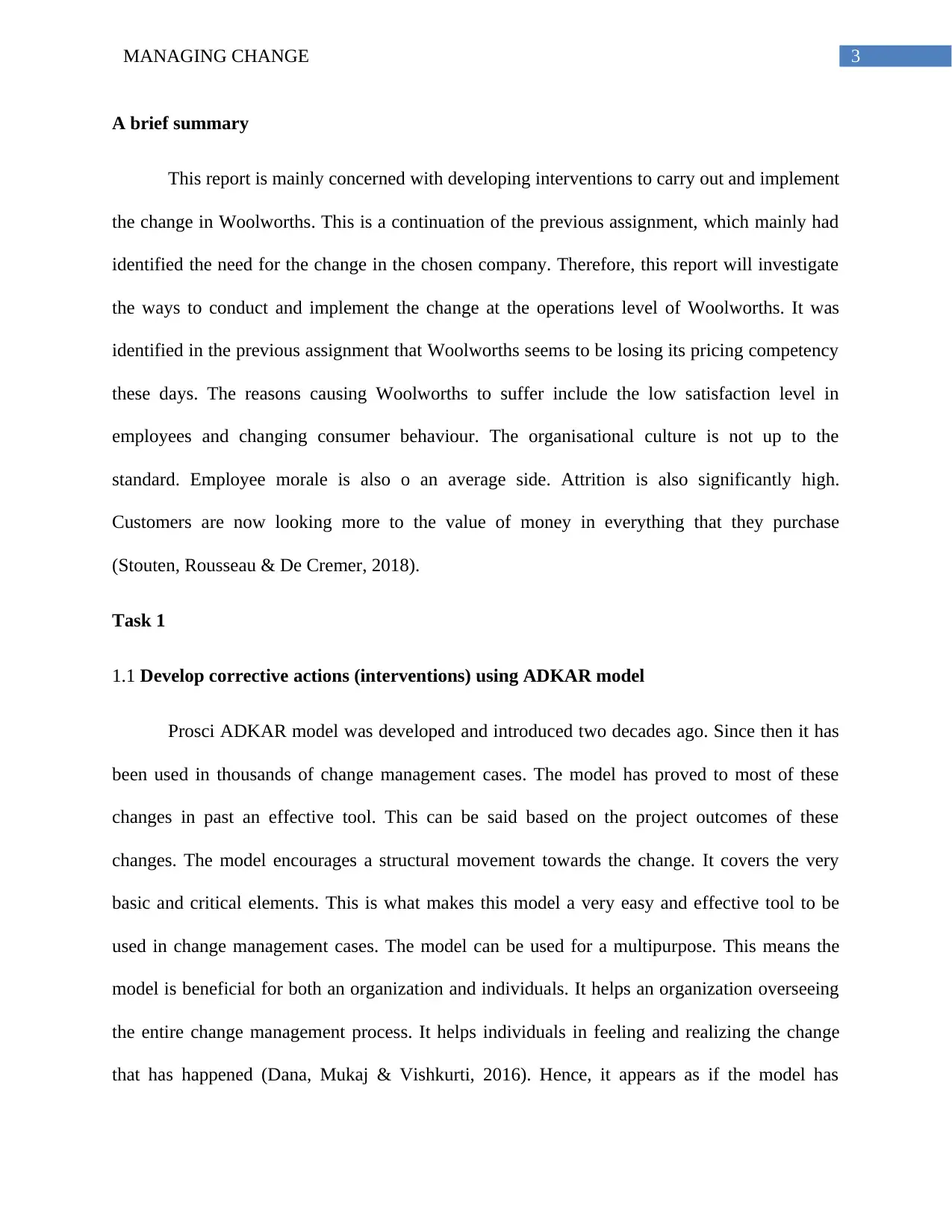
3MANAGING CHANGE
A brief summary
This report is mainly concerned with developing interventions to carry out and implement
the change in Woolworths. This is a continuation of the previous assignment, which mainly had
identified the need for the change in the chosen company. Therefore, this report will investigate
the ways to conduct and implement the change at the operations level of Woolworths. It was
identified in the previous assignment that Woolworths seems to be losing its pricing competency
these days. The reasons causing Woolworths to suffer include the low satisfaction level in
employees and changing consumer behaviour. The organisational culture is not up to the
standard. Employee morale is also o an average side. Attrition is also significantly high.
Customers are now looking more to the value of money in everything that they purchase
(Stouten, Rousseau & De Cremer, 2018).
Task 1
1.1 Develop corrective actions (interventions) using ADKAR model
Prosci ADKAR model was developed and introduced two decades ago. Since then it has
been used in thousands of change management cases. The model has proved to most of these
changes in past an effective tool. This can be said based on the project outcomes of these
changes. The model encourages a structural movement towards the change. It covers the very
basic and critical elements. This is what makes this model a very easy and effective tool to be
used in change management cases. The model can be used for a multipurpose. This means the
model is beneficial for both an organization and individuals. It helps an organization overseeing
the entire change management process. It helps individuals in feeling and realizing the change
that has happened (Dana, Mukaj & Vishkurti, 2016). Hence, it appears as if the model has
A brief summary
This report is mainly concerned with developing interventions to carry out and implement
the change in Woolworths. This is a continuation of the previous assignment, which mainly had
identified the need for the change in the chosen company. Therefore, this report will investigate
the ways to conduct and implement the change at the operations level of Woolworths. It was
identified in the previous assignment that Woolworths seems to be losing its pricing competency
these days. The reasons causing Woolworths to suffer include the low satisfaction level in
employees and changing consumer behaviour. The organisational culture is not up to the
standard. Employee morale is also o an average side. Attrition is also significantly high.
Customers are now looking more to the value of money in everything that they purchase
(Stouten, Rousseau & De Cremer, 2018).
Task 1
1.1 Develop corrective actions (interventions) using ADKAR model
Prosci ADKAR model was developed and introduced two decades ago. Since then it has
been used in thousands of change management cases. The model has proved to most of these
changes in past an effective tool. This can be said based on the project outcomes of these
changes. The model encourages a structural movement towards the change. It covers the very
basic and critical elements. This is what makes this model a very easy and effective tool to be
used in change management cases. The model can be used for a multipurpose. This means the
model is beneficial for both an organization and individuals. It helps an organization overseeing
the entire change management process. It helps individuals in feeling and realizing the change
that has happened (Dana, Mukaj & Vishkurti, 2016). Hence, it appears as if the model has
Paraphrase This Document
Need a fresh take? Get an instant paraphrase of this document with our AI Paraphraser
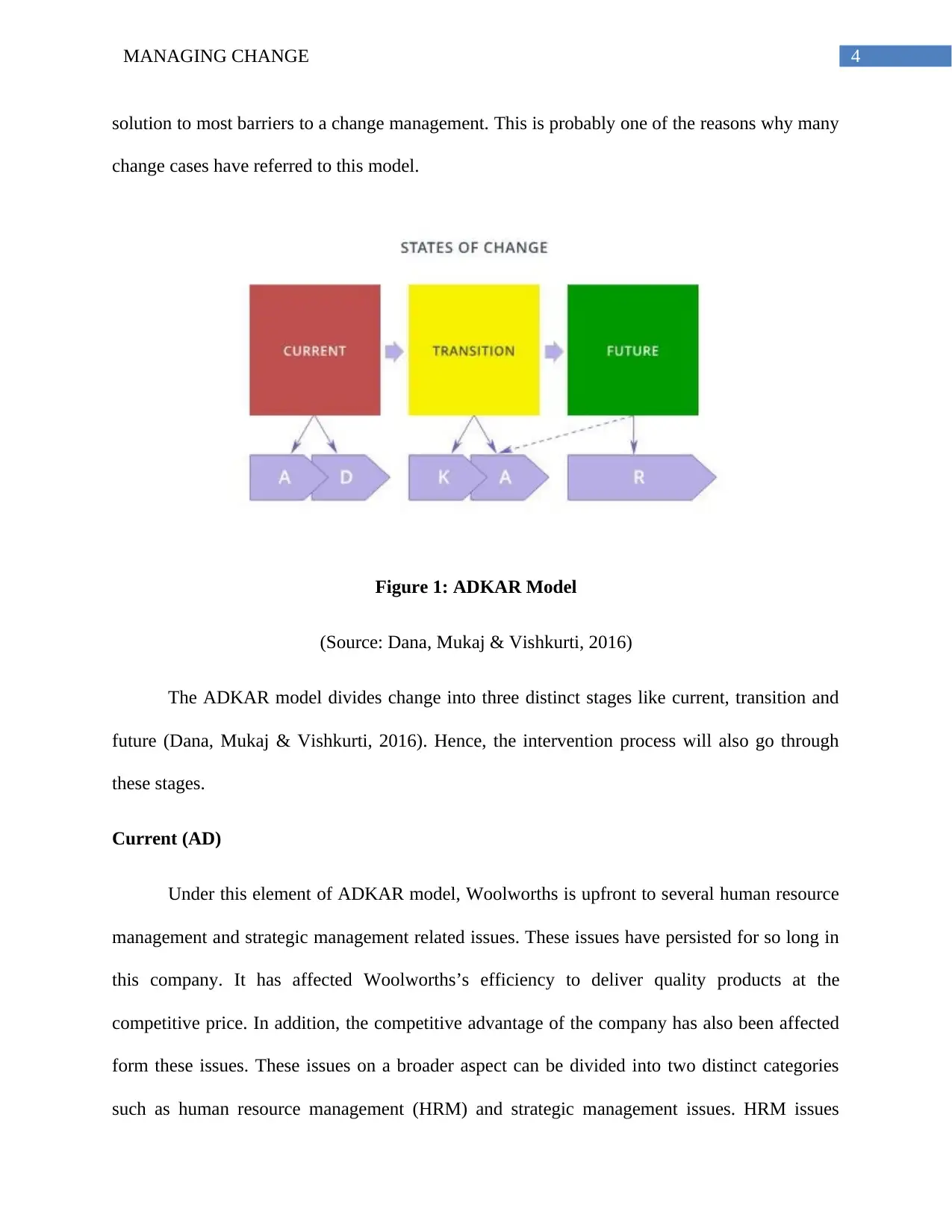
4MANAGING CHANGE
solution to most barriers to a change management. This is probably one of the reasons why many
change cases have referred to this model.
Figure 1: ADKAR Model
(Source: Dana, Mukaj & Vishkurti, 2016)
The ADKAR model divides change into three distinct stages like current, transition and
future (Dana, Mukaj & Vishkurti, 2016). Hence, the intervention process will also go through
these stages.
Current (AD)
Under this element of ADKAR model, Woolworths is upfront to several human resource
management and strategic management related issues. These issues have persisted for so long in
this company. It has affected Woolworths’s efficiency to deliver quality products at the
competitive price. In addition, the competitive advantage of the company has also been affected
form these issues. These issues on a broader aspect can be divided into two distinct categories
such as human resource management (HRM) and strategic management issues. HRM issues
solution to most barriers to a change management. This is probably one of the reasons why many
change cases have referred to this model.
Figure 1: ADKAR Model
(Source: Dana, Mukaj & Vishkurti, 2016)
The ADKAR model divides change into three distinct stages like current, transition and
future (Dana, Mukaj & Vishkurti, 2016). Hence, the intervention process will also go through
these stages.
Current (AD)
Under this element of ADKAR model, Woolworths is upfront to several human resource
management and strategic management related issues. These issues have persisted for so long in
this company. It has affected Woolworths’s efficiency to deliver quality products at the
competitive price. In addition, the competitive advantage of the company has also been affected
form these issues. These issues on a broader aspect can be divided into two distinct categories
such as human resource management (HRM) and strategic management issues. HRM issues
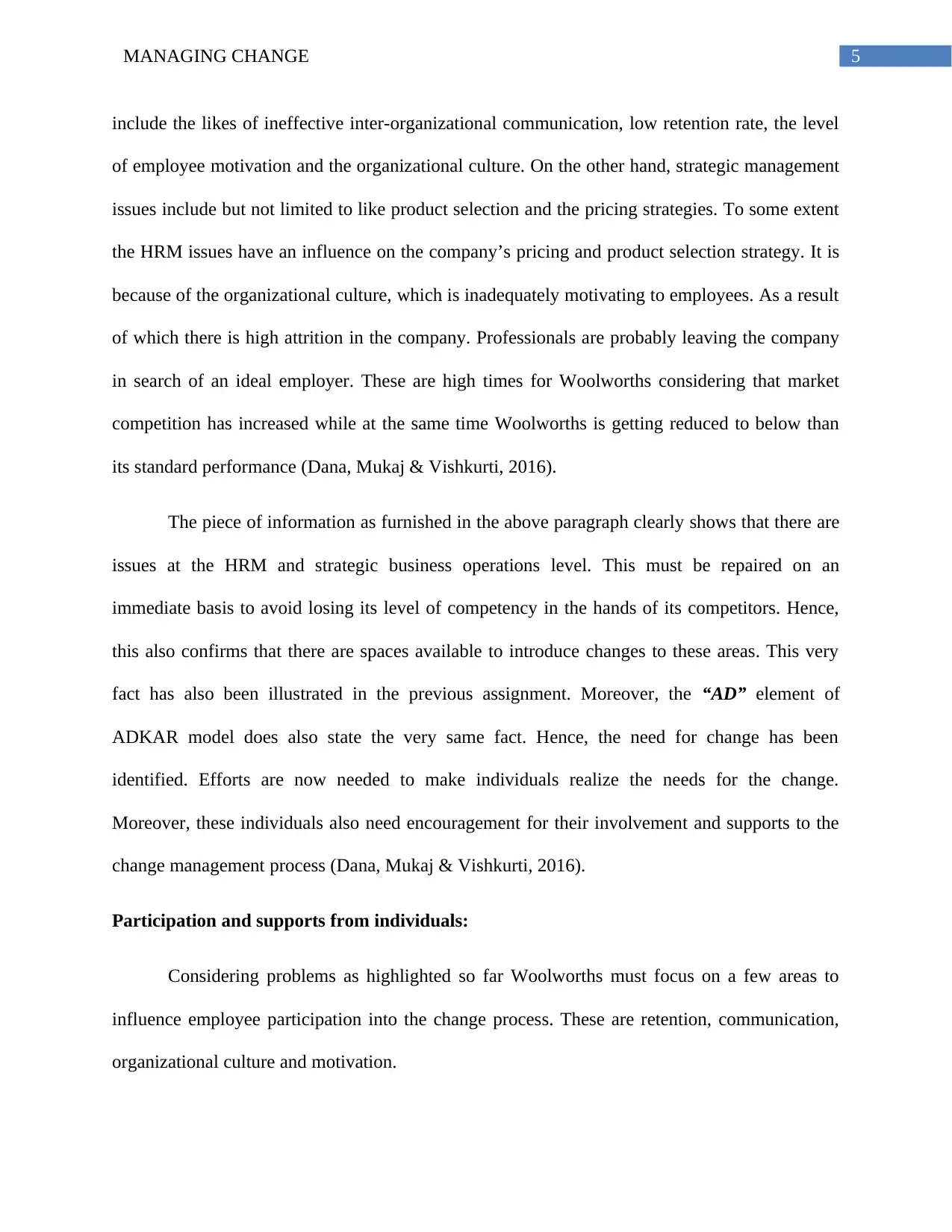
5MANAGING CHANGE
include the likes of ineffective inter-organizational communication, low retention rate, the level
of employee motivation and the organizational culture. On the other hand, strategic management
issues include but not limited to like product selection and the pricing strategies. To some extent
the HRM issues have an influence on the company’s pricing and product selection strategy. It is
because of the organizational culture, which is inadequately motivating to employees. As a result
of which there is high attrition in the company. Professionals are probably leaving the company
in search of an ideal employer. These are high times for Woolworths considering that market
competition has increased while at the same time Woolworths is getting reduced to below than
its standard performance (Dana, Mukaj & Vishkurti, 2016).
The piece of information as furnished in the above paragraph clearly shows that there are
issues at the HRM and strategic business operations level. This must be repaired on an
immediate basis to avoid losing its level of competency in the hands of its competitors. Hence,
this also confirms that there are spaces available to introduce changes to these areas. This very
fact has also been illustrated in the previous assignment. Moreover, the “AD” element of
ADKAR model does also state the very same fact. Hence, the need for change has been
identified. Efforts are now needed to make individuals realize the needs for the change.
Moreover, these individuals also need encouragement for their involvement and supports to the
change management process (Dana, Mukaj & Vishkurti, 2016).
Participation and supports from individuals:
Considering problems as highlighted so far Woolworths must focus on a few areas to
influence employee participation into the change process. These are retention, communication,
organizational culture and motivation.
include the likes of ineffective inter-organizational communication, low retention rate, the level
of employee motivation and the organizational culture. On the other hand, strategic management
issues include but not limited to like product selection and the pricing strategies. To some extent
the HRM issues have an influence on the company’s pricing and product selection strategy. It is
because of the organizational culture, which is inadequately motivating to employees. As a result
of which there is high attrition in the company. Professionals are probably leaving the company
in search of an ideal employer. These are high times for Woolworths considering that market
competition has increased while at the same time Woolworths is getting reduced to below than
its standard performance (Dana, Mukaj & Vishkurti, 2016).
The piece of information as furnished in the above paragraph clearly shows that there are
issues at the HRM and strategic business operations level. This must be repaired on an
immediate basis to avoid losing its level of competency in the hands of its competitors. Hence,
this also confirms that there are spaces available to introduce changes to these areas. This very
fact has also been illustrated in the previous assignment. Moreover, the “AD” element of
ADKAR model does also state the very same fact. Hence, the need for change has been
identified. Efforts are now needed to make individuals realize the needs for the change.
Moreover, these individuals also need encouragement for their involvement and supports to the
change management process (Dana, Mukaj & Vishkurti, 2016).
Participation and supports from individuals:
Considering problems as highlighted so far Woolworths must focus on a few areas to
influence employee participation into the change process. These are retention, communication,
organizational culture and motivation.
⊘ This is a preview!⊘
Do you want full access?
Subscribe today to unlock all pages.

Trusted by 1+ million students worldwide
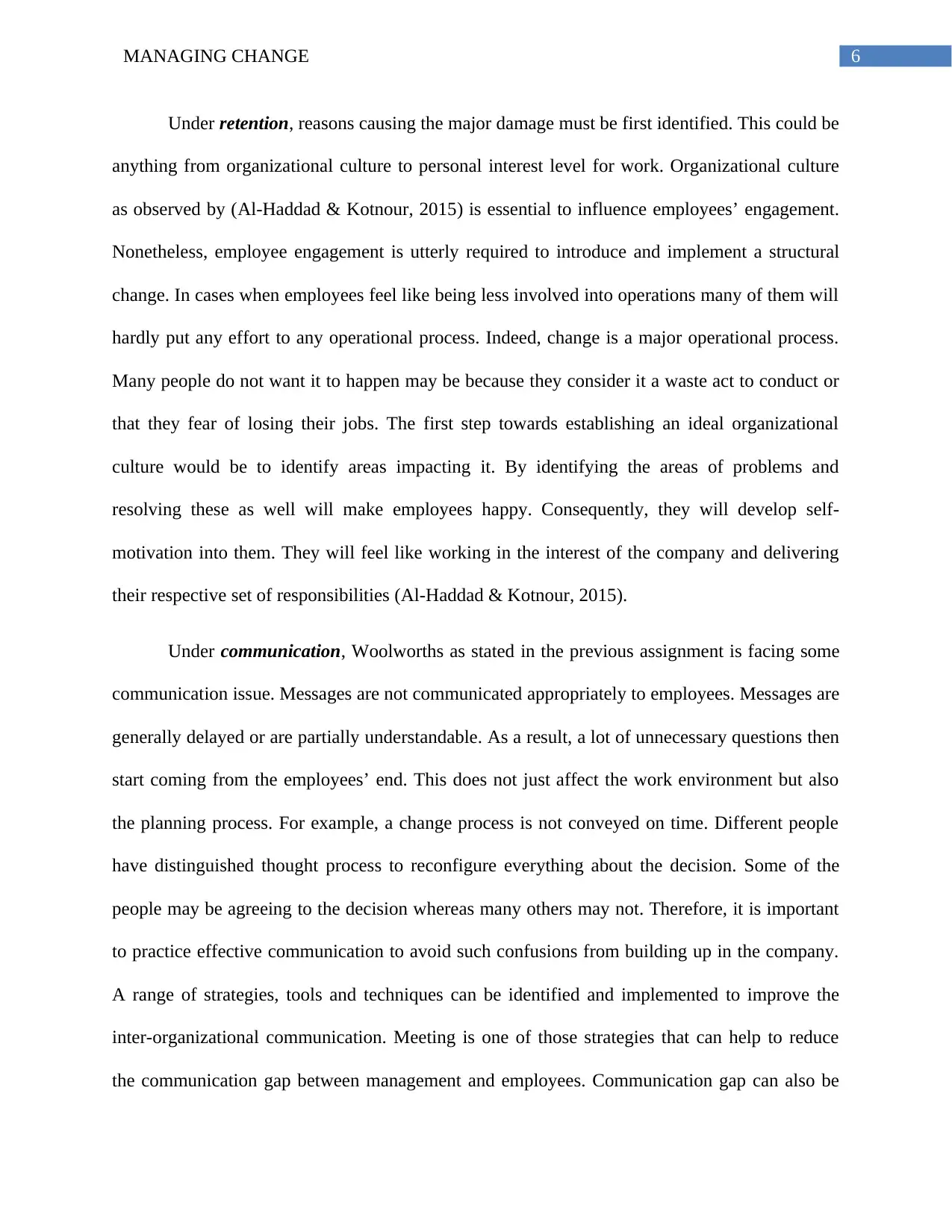
6MANAGING CHANGE
Under retention, reasons causing the major damage must be first identified. This could be
anything from organizational culture to personal interest level for work. Organizational culture
as observed by (Al-Haddad & Kotnour, 2015) is essential to influence employees’ engagement.
Nonetheless, employee engagement is utterly required to introduce and implement a structural
change. In cases when employees feel like being less involved into operations many of them will
hardly put any effort to any operational process. Indeed, change is a major operational process.
Many people do not want it to happen may be because they consider it a waste act to conduct or
that they fear of losing their jobs. The first step towards establishing an ideal organizational
culture would be to identify areas impacting it. By identifying the areas of problems and
resolving these as well will make employees happy. Consequently, they will develop self-
motivation into them. They will feel like working in the interest of the company and delivering
their respective set of responsibilities (Al-Haddad & Kotnour, 2015).
Under communication, Woolworths as stated in the previous assignment is facing some
communication issue. Messages are not communicated appropriately to employees. Messages are
generally delayed or are partially understandable. As a result, a lot of unnecessary questions then
start coming from the employees’ end. This does not just affect the work environment but also
the planning process. For example, a change process is not conveyed on time. Different people
have distinguished thought process to reconfigure everything about the decision. Some of the
people may be agreeing to the decision whereas many others may not. Therefore, it is important
to practice effective communication to avoid such confusions from building up in the company.
A range of strategies, tools and techniques can be identified and implemented to improve the
inter-organizational communication. Meeting is one of those strategies that can help to reduce
the communication gap between management and employees. Communication gap can also be
Under retention, reasons causing the major damage must be first identified. This could be
anything from organizational culture to personal interest level for work. Organizational culture
as observed by (Al-Haddad & Kotnour, 2015) is essential to influence employees’ engagement.
Nonetheless, employee engagement is utterly required to introduce and implement a structural
change. In cases when employees feel like being less involved into operations many of them will
hardly put any effort to any operational process. Indeed, change is a major operational process.
Many people do not want it to happen may be because they consider it a waste act to conduct or
that they fear of losing their jobs. The first step towards establishing an ideal organizational
culture would be to identify areas impacting it. By identifying the areas of problems and
resolving these as well will make employees happy. Consequently, they will develop self-
motivation into them. They will feel like working in the interest of the company and delivering
their respective set of responsibilities (Al-Haddad & Kotnour, 2015).
Under communication, Woolworths as stated in the previous assignment is facing some
communication issue. Messages are not communicated appropriately to employees. Messages are
generally delayed or are partially understandable. As a result, a lot of unnecessary questions then
start coming from the employees’ end. This does not just affect the work environment but also
the planning process. For example, a change process is not conveyed on time. Different people
have distinguished thought process to reconfigure everything about the decision. Some of the
people may be agreeing to the decision whereas many others may not. Therefore, it is important
to practice effective communication to avoid such confusions from building up in the company.
A range of strategies, tools and techniques can be identified and implemented to improve the
inter-organizational communication. Meeting is one of those strategies that can help to reduce
the communication gap between management and employees. Communication gap can also be
Paraphrase This Document
Need a fresh take? Get an instant paraphrase of this document with our AI Paraphraser
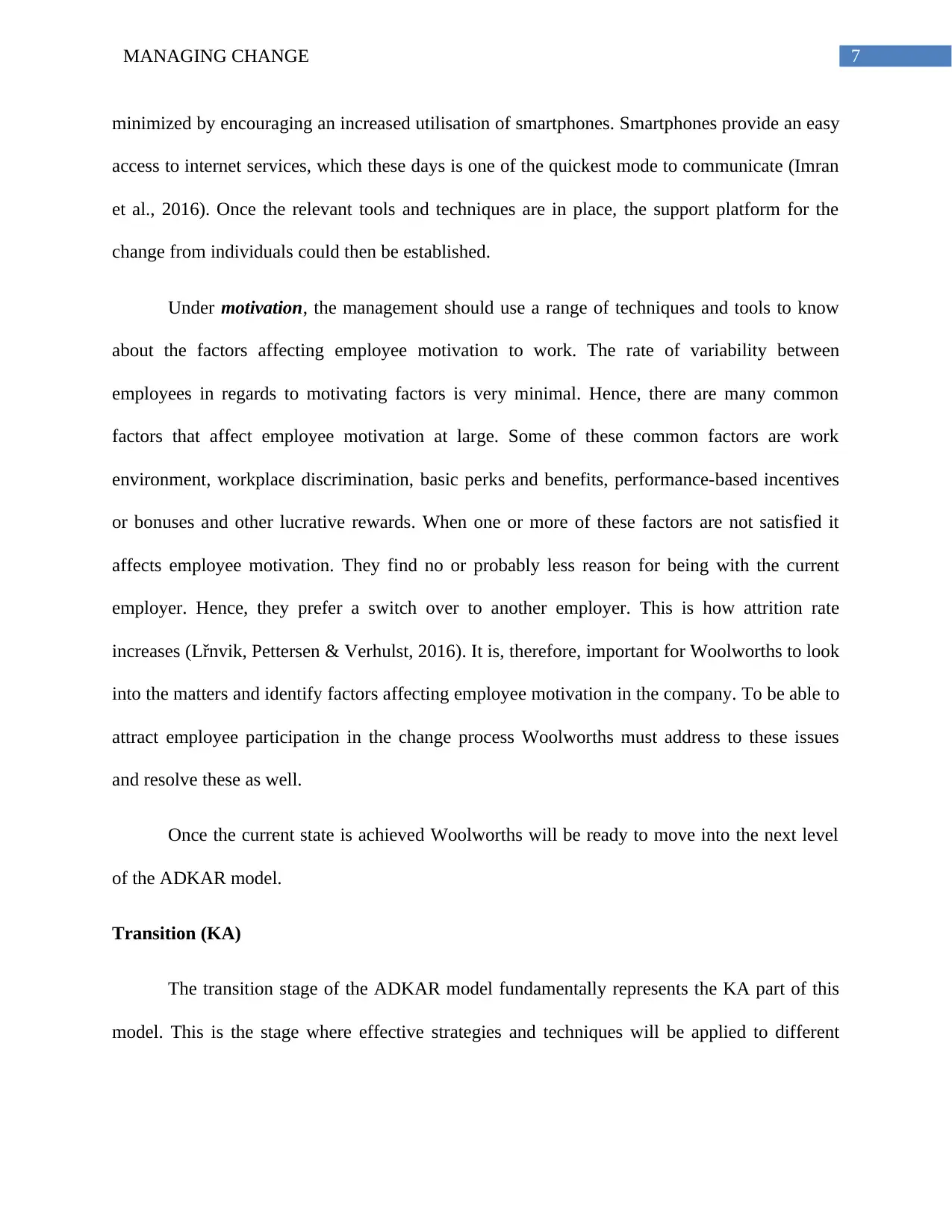
7MANAGING CHANGE
minimized by encouraging an increased utilisation of smartphones. Smartphones provide an easy
access to internet services, which these days is one of the quickest mode to communicate (Imran
et al., 2016). Once the relevant tools and techniques are in place, the support platform for the
change from individuals could then be established.
Under motivation, the management should use a range of techniques and tools to know
about the factors affecting employee motivation to work. The rate of variability between
employees in regards to motivating factors is very minimal. Hence, there are many common
factors that affect employee motivation at large. Some of these common factors are work
environment, workplace discrimination, basic perks and benefits, performance-based incentives
or bonuses and other lucrative rewards. When one or more of these factors are not satisfied it
affects employee motivation. They find no or probably less reason for being with the current
employer. Hence, they prefer a switch over to another employer. This is how attrition rate
increases (Lřnvik, Pettersen & Verhulst, 2016). It is, therefore, important for Woolworths to look
into the matters and identify factors affecting employee motivation in the company. To be able to
attract employee participation in the change process Woolworths must address to these issues
and resolve these as well.
Once the current state is achieved Woolworths will be ready to move into the next level
of the ADKAR model.
Transition (KA)
The transition stage of the ADKAR model fundamentally represents the KA part of this
model. This is the stage where effective strategies and techniques will be applied to different
minimized by encouraging an increased utilisation of smartphones. Smartphones provide an easy
access to internet services, which these days is one of the quickest mode to communicate (Imran
et al., 2016). Once the relevant tools and techniques are in place, the support platform for the
change from individuals could then be established.
Under motivation, the management should use a range of techniques and tools to know
about the factors affecting employee motivation to work. The rate of variability between
employees in regards to motivating factors is very minimal. Hence, there are many common
factors that affect employee motivation at large. Some of these common factors are work
environment, workplace discrimination, basic perks and benefits, performance-based incentives
or bonuses and other lucrative rewards. When one or more of these factors are not satisfied it
affects employee motivation. They find no or probably less reason for being with the current
employer. Hence, they prefer a switch over to another employer. This is how attrition rate
increases (Lřnvik, Pettersen & Verhulst, 2016). It is, therefore, important for Woolworths to look
into the matters and identify factors affecting employee motivation in the company. To be able to
attract employee participation in the change process Woolworths must address to these issues
and resolve these as well.
Once the current state is achieved Woolworths will be ready to move into the next level
of the ADKAR model.
Transition (KA)
The transition stage of the ADKAR model fundamentally represents the KA part of this
model. This is the stage where effective strategies and techniques will be applied to different
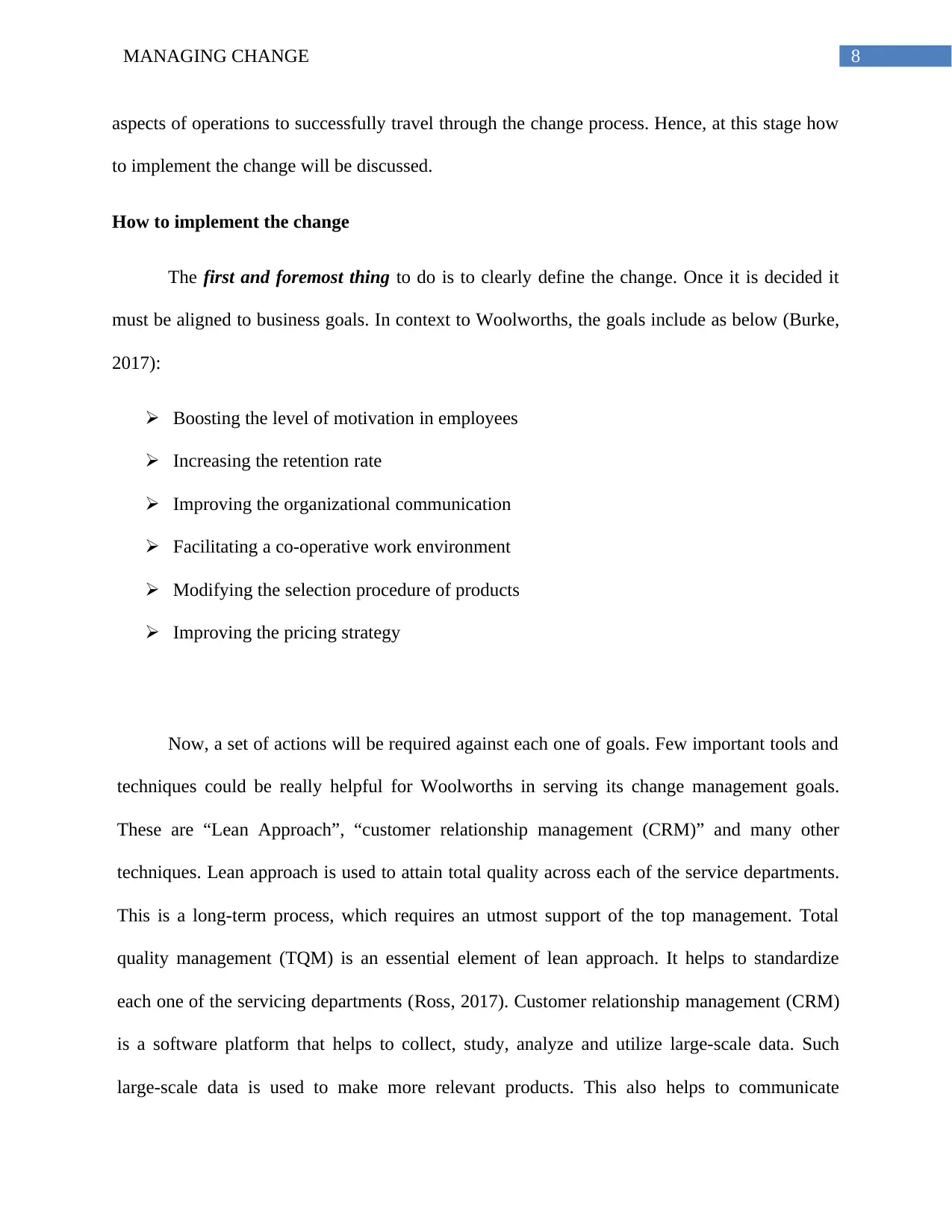
8MANAGING CHANGE
aspects of operations to successfully travel through the change process. Hence, at this stage how
to implement the change will be discussed.
How to implement the change
The first and foremost thing to do is to clearly define the change. Once it is decided it
must be aligned to business goals. In context to Woolworths, the goals include as below (Burke,
2017):
Boosting the level of motivation in employees
Increasing the retention rate
Improving the organizational communication
Facilitating a co-operative work environment
Modifying the selection procedure of products
Improving the pricing strategy
Now, a set of actions will be required against each one of goals. Few important tools and
techniques could be really helpful for Woolworths in serving its change management goals.
These are “Lean Approach”, “customer relationship management (CRM)” and many other
techniques. Lean approach is used to attain total quality across each of the service departments.
This is a long-term process, which requires an utmost support of the top management. Total
quality management (TQM) is an essential element of lean approach. It helps to standardize
each one of the servicing departments (Ross, 2017). Customer relationship management (CRM)
is a software platform that helps to collect, study, analyze and utilize large-scale data. Such
large-scale data is used to make more relevant products. This also helps to communicate
aspects of operations to successfully travel through the change process. Hence, at this stage how
to implement the change will be discussed.
How to implement the change
The first and foremost thing to do is to clearly define the change. Once it is decided it
must be aligned to business goals. In context to Woolworths, the goals include as below (Burke,
2017):
Boosting the level of motivation in employees
Increasing the retention rate
Improving the organizational communication
Facilitating a co-operative work environment
Modifying the selection procedure of products
Improving the pricing strategy
Now, a set of actions will be required against each one of goals. Few important tools and
techniques could be really helpful for Woolworths in serving its change management goals.
These are “Lean Approach”, “customer relationship management (CRM)” and many other
techniques. Lean approach is used to attain total quality across each of the service departments.
This is a long-term process, which requires an utmost support of the top management. Total
quality management (TQM) is an essential element of lean approach. It helps to standardize
each one of the servicing departments (Ross, 2017). Customer relationship management (CRM)
is a software platform that helps to collect, study, analyze and utilize large-scale data. Such
large-scale data is used to make more relevant products. This also helps to communicate
⊘ This is a preview!⊘
Do you want full access?
Subscribe today to unlock all pages.

Trusted by 1+ million students worldwide
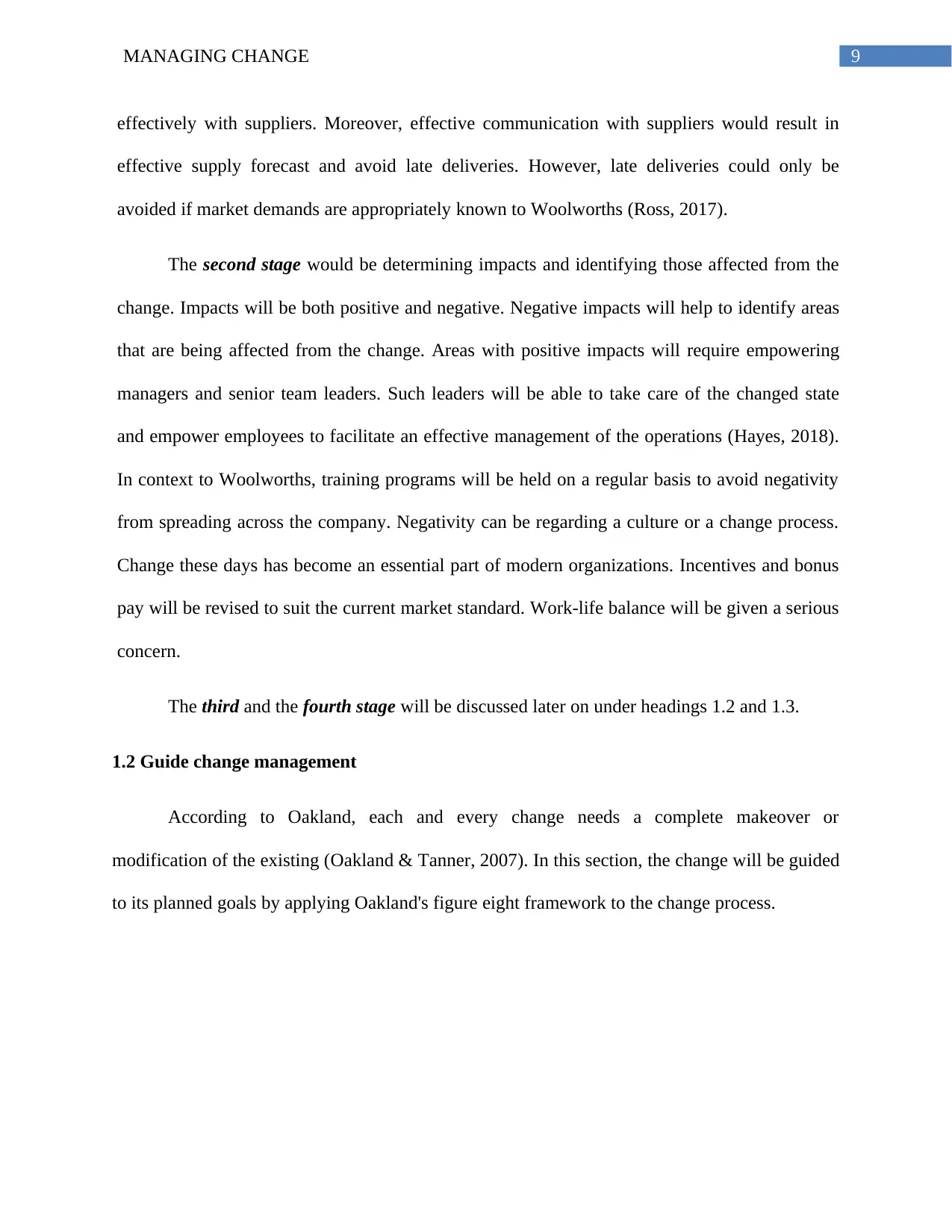
9MANAGING CHANGE
effectively with suppliers. Moreover, effective communication with suppliers would result in
effective supply forecast and avoid late deliveries. However, late deliveries could only be
avoided if market demands are appropriately known to Woolworths (Ross, 2017).
The second stage would be determining impacts and identifying those affected from the
change. Impacts will be both positive and negative. Negative impacts will help to identify areas
that are being affected from the change. Areas with positive impacts will require empowering
managers and senior team leaders. Such leaders will be able to take care of the changed state
and empower employees to facilitate an effective management of the operations (Hayes, 2018).
In context to Woolworths, training programs will be held on a regular basis to avoid negativity
from spreading across the company. Negativity can be regarding a culture or a change process.
Change these days has become an essential part of modern organizations. Incentives and bonus
pay will be revised to suit the current market standard. Work-life balance will be given a serious
concern.
The third and the fourth stage will be discussed later on under headings 1.2 and 1.3.
1.2 Guide change management
According to Oakland, each and every change needs a complete makeover or
modification of the existing (Oakland & Tanner, 2007). In this section, the change will be guided
to its planned goals by applying Oakland's figure eight framework to the change process.
effectively with suppliers. Moreover, effective communication with suppliers would result in
effective supply forecast and avoid late deliveries. However, late deliveries could only be
avoided if market demands are appropriately known to Woolworths (Ross, 2017).
The second stage would be determining impacts and identifying those affected from the
change. Impacts will be both positive and negative. Negative impacts will help to identify areas
that are being affected from the change. Areas with positive impacts will require empowering
managers and senior team leaders. Such leaders will be able to take care of the changed state
and empower employees to facilitate an effective management of the operations (Hayes, 2018).
In context to Woolworths, training programs will be held on a regular basis to avoid negativity
from spreading across the company. Negativity can be regarding a culture or a change process.
Change these days has become an essential part of modern organizations. Incentives and bonus
pay will be revised to suit the current market standard. Work-life balance will be given a serious
concern.
The third and the fourth stage will be discussed later on under headings 1.2 and 1.3.
1.2 Guide change management
According to Oakland, each and every change needs a complete makeover or
modification of the existing (Oakland & Tanner, 2007). In this section, the change will be guided
to its planned goals by applying Oakland's figure eight framework to the change process.
Paraphrase This Document
Need a fresh take? Get an instant paraphrase of this document with our AI Paraphraser
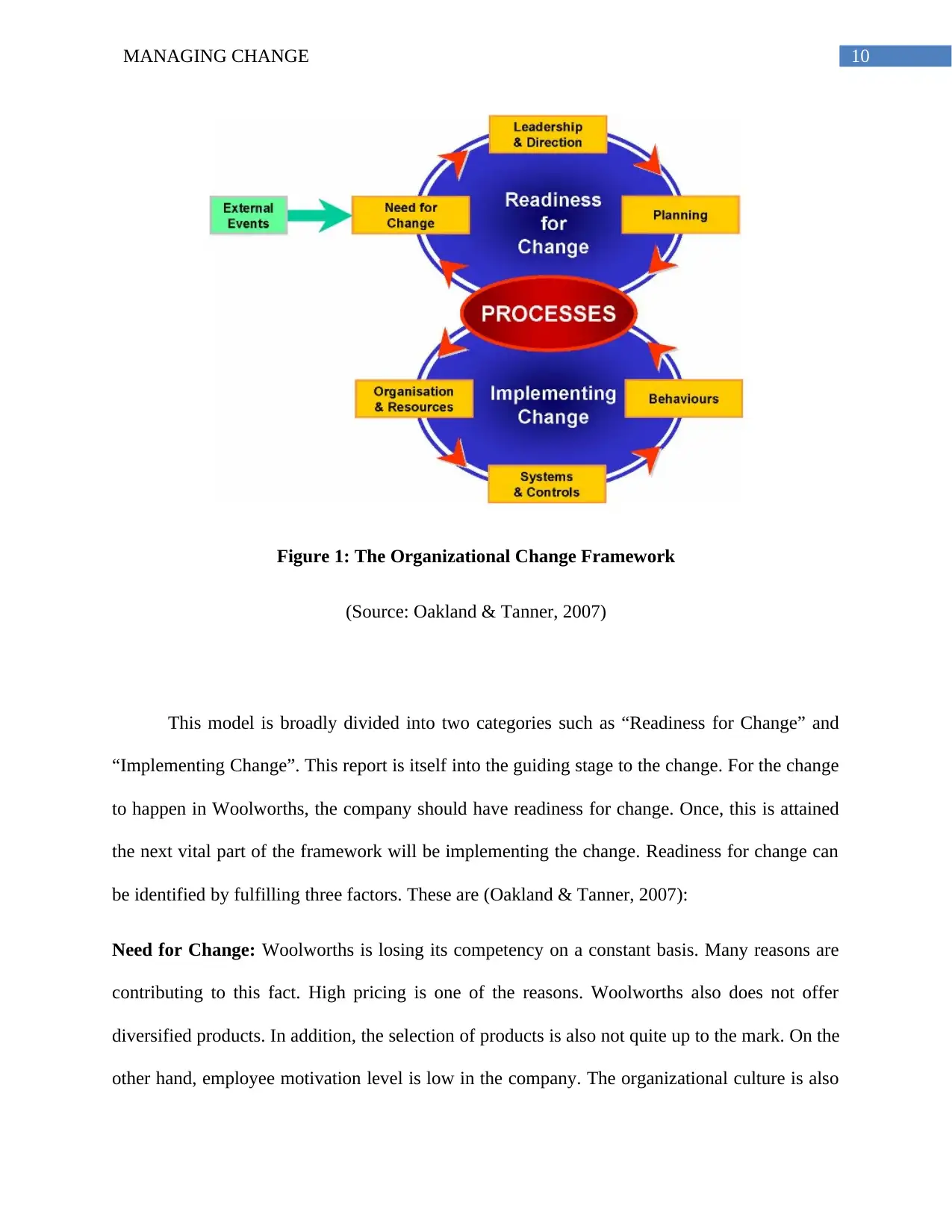
10MANAGING CHANGE
Figure 1: The Organizational Change Framework
(Source: Oakland & Tanner, 2007)
This model is broadly divided into two categories such as “Readiness for Change” and
“Implementing Change”. This report is itself into the guiding stage to the change. For the change
to happen in Woolworths, the company should have readiness for change. Once, this is attained
the next vital part of the framework will be implementing the change. Readiness for change can
be identified by fulfilling three factors. These are (Oakland & Tanner, 2007):
Need for Change: Woolworths is losing its competency on a constant basis. Many reasons are
contributing to this fact. High pricing is one of the reasons. Woolworths also does not offer
diversified products. In addition, the selection of products is also not quite up to the mark. On the
other hand, employee motivation level is low in the company. The organizational culture is also
Figure 1: The Organizational Change Framework
(Source: Oakland & Tanner, 2007)
This model is broadly divided into two categories such as “Readiness for Change” and
“Implementing Change”. This report is itself into the guiding stage to the change. For the change
to happen in Woolworths, the company should have readiness for change. Once, this is attained
the next vital part of the framework will be implementing the change. Readiness for change can
be identified by fulfilling three factors. These are (Oakland & Tanner, 2007):
Need for Change: Woolworths is losing its competency on a constant basis. Many reasons are
contributing to this fact. High pricing is one of the reasons. Woolworths also does not offer
diversified products. In addition, the selection of products is also not quite up to the mark. On the
other hand, employee motivation level is low in the company. The organizational culture is also
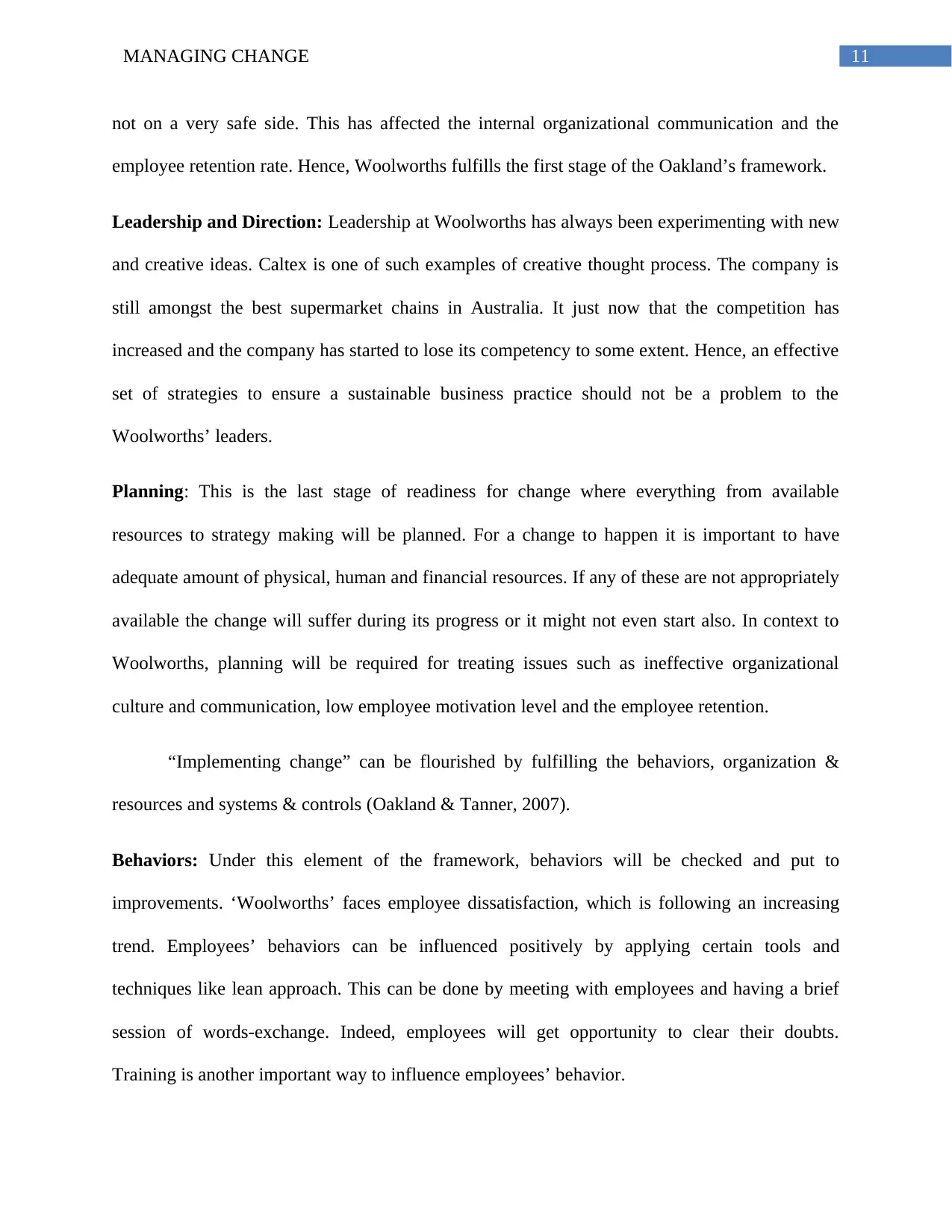
11MANAGING CHANGE
not on a very safe side. This has affected the internal organizational communication and the
employee retention rate. Hence, Woolworths fulfills the first stage of the Oakland’s framework.
Leadership and Direction: Leadership at Woolworths has always been experimenting with new
and creative ideas. Caltex is one of such examples of creative thought process. The company is
still amongst the best supermarket chains in Australia. It just now that the competition has
increased and the company has started to lose its competency to some extent. Hence, an effective
set of strategies to ensure a sustainable business practice should not be a problem to the
Woolworths’ leaders.
Planning: This is the last stage of readiness for change where everything from available
resources to strategy making will be planned. For a change to happen it is important to have
adequate amount of physical, human and financial resources. If any of these are not appropriately
available the change will suffer during its progress or it might not even start also. In context to
Woolworths, planning will be required for treating issues such as ineffective organizational
culture and communication, low employee motivation level and the employee retention.
“Implementing change” can be flourished by fulfilling the behaviors, organization &
resources and systems & controls (Oakland & Tanner, 2007).
Behaviors: Under this element of the framework, behaviors will be checked and put to
improvements. ‘Woolworths’ faces employee dissatisfaction, which is following an increasing
trend. Employees’ behaviors can be influenced positively by applying certain tools and
techniques like lean approach. This can be done by meeting with employees and having a brief
session of words-exchange. Indeed, employees will get opportunity to clear their doubts.
Training is another important way to influence employees’ behavior.
not on a very safe side. This has affected the internal organizational communication and the
employee retention rate. Hence, Woolworths fulfills the first stage of the Oakland’s framework.
Leadership and Direction: Leadership at Woolworths has always been experimenting with new
and creative ideas. Caltex is one of such examples of creative thought process. The company is
still amongst the best supermarket chains in Australia. It just now that the competition has
increased and the company has started to lose its competency to some extent. Hence, an effective
set of strategies to ensure a sustainable business practice should not be a problem to the
Woolworths’ leaders.
Planning: This is the last stage of readiness for change where everything from available
resources to strategy making will be planned. For a change to happen it is important to have
adequate amount of physical, human and financial resources. If any of these are not appropriately
available the change will suffer during its progress or it might not even start also. In context to
Woolworths, planning will be required for treating issues such as ineffective organizational
culture and communication, low employee motivation level and the employee retention.
“Implementing change” can be flourished by fulfilling the behaviors, organization &
resources and systems & controls (Oakland & Tanner, 2007).
Behaviors: Under this element of the framework, behaviors will be checked and put to
improvements. ‘Woolworths’ faces employee dissatisfaction, which is following an increasing
trend. Employees’ behaviors can be influenced positively by applying certain tools and
techniques like lean approach. This can be done by meeting with employees and having a brief
session of words-exchange. Indeed, employees will get opportunity to clear their doubts.
Training is another important way to influence employees’ behavior.
⊘ This is a preview!⊘
Do you want full access?
Subscribe today to unlock all pages.

Trusted by 1+ million students worldwide
1 out of 18
Related Documents
Your All-in-One AI-Powered Toolkit for Academic Success.
+13062052269
info@desklib.com
Available 24*7 on WhatsApp / Email
![[object Object]](/_next/static/media/star-bottom.7253800d.svg)
Unlock your academic potential
Copyright © 2020–2025 A2Z Services. All Rights Reserved. Developed and managed by ZUCOL.





